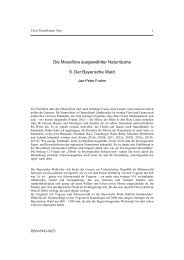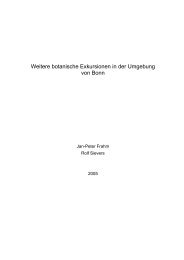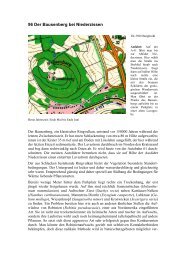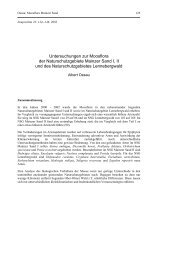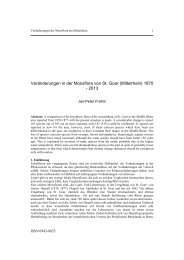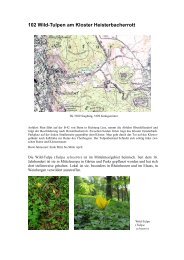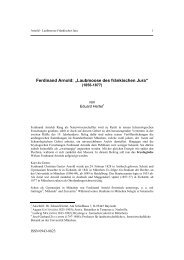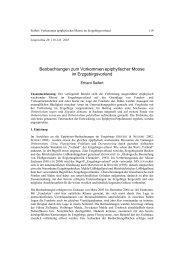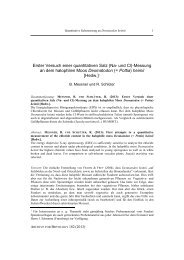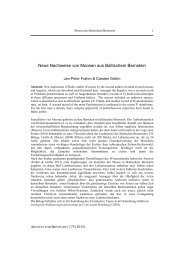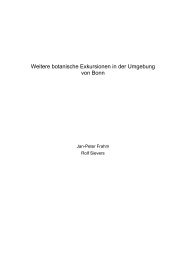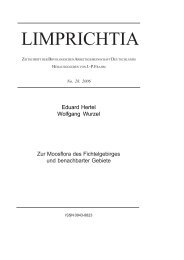Archive 81.pdf - Jan-Peter Frahm
Archive 81.pdf - Jan-Peter Frahm
Archive 81.pdf - Jan-Peter Frahm
You also want an ePaper? Increase the reach of your titles
YUMPU automatically turns print PDFs into web optimized ePapers that Google loves.
ARCHIVE FOR BRYOLOGY 81 (2011)<br />
Orthotrichum fastigiatum<br />
The taxonomic status of Orthotrichum fastigiatum<br />
<strong>Jan</strong>-<strong>Peter</strong> <strong>Frahm</strong><br />
Abstract: Orthotrichum fastigiatum has variously been treated as a species or as subscpecies,<br />
variety or even as synonym of O. affine. The distinguishing characters between both taxa were<br />
studied. An evaluation revealed that some characters such as spore size (different but<br />
intergrading), exostome ornamentation, leaf apex, shape of papillae and lid cannot be used for<br />
differentiation. Other characters of O. fastigiatum such as smaller size, capsules imbedded in the<br />
leaves, a naked calyptra, the width of the ribs of the urn and the extend to which the empty capsule<br />
is contracted below the mouth are usable but hardly to quantify. The observation of mixed stands<br />
as well an apparent different ecology indicates different genotypes. Therefore O. fastigiatum<br />
should be regarded as infraspecific taxon of O. affine.<br />
INTRODUCTION<br />
There is a consistent discussion in taxonomy, whether a taxon deserves recognition and, if yes, on<br />
which level. One of the example of doubtful taxonomic status is Orthotrichum fastigiatum, which<br />
was originally described as a species by Bruch in Bridel already in 1827 but later reduced to the<br />
rank of a subspecies or variety and today often no more recognized.<br />
Orthotrichum fastigiatum Bruch ex Brid., Bryol. Univ. 1: 785, 1827.<br />
Orthotrichum affine Schrad. ex Brid., Musc. Rec. 2: 22, 1801<br />
ssp. fastigiatum (Brid.) Hartm., Skand. Fl. Ed. 4: 322, 1938<br />
var. fastigiatum (Brid.) Hüb.. Musc. Ger, 365, 1833<br />
In the protologue, Bruch admitted that O. fastigiatum is not easy distinguishable (“nec facile ab eo<br />
dignoscendum”) from the most similar (“simillimum”) O. affine. He differentiated O. fastigiatum<br />
by<br />
(1) erose-denticulate leaves<br />
(2) lacunose exostome<br />
(3) an articulate endostome consisting of only one cell row, much more robust than in other<br />
species of the genus<br />
(4) a calyptra which is smooth or has only few hairs, which is fringed at base.<br />
Already Hübener in 1833 reduced O. fastigiatum to the rank of a variety. He wrote that it is even<br />
as a variety difficult and critical to distinguish by the form of the peristome teeth, of which the<br />
1
2<br />
<strong>Frahm</strong><br />
exostome is irregularly lacunose and the endostome is more robust and stronger articulate.<br />
Vegetatively the plants are smaller, the calyptra shorter and less hairy. Interestingly these<br />
characters mentioned are different from those which were used later. Mönkemeyer (1927)<br />
recognized O. fastigiatum as variety, which shall mainly be differentiated by lower plants and<br />
broadly ribbed capsules, characters, which hardly allow to separate both taxa.<br />
Nyholm (1954-69) accepted O. fastigiatum as a species distinguished from O. affine by short<br />
setae, broad striae on the capsule, irregularly striate peristome teeth and smooth calyptra and the<br />
lid bordered with 3-5 rows of red, much shortened cells. The latter character is not mentioned in<br />
the key and seems also to fit O. affine. In contrast, O. affine shall be characterized by elongate<br />
setae, narrow striae, usually papillose peristome teeth and a smooth or hairy calyptra. Because of<br />
the wide variation, she did not illustrate O. affine. However, in the second edition of her moss<br />
flora (Nyholm 1998), she changed her mind and writes under O. affine: “It has been sometimes<br />
named O. affine, sometimes O. fastigiatum, or regarded as hybrid between O. speciosum and O.<br />
fastigiatum. I prefer to regard it as one very variable taxon.” As illustration of O. affine she uses<br />
that of O. fastigiatum from the first edition.<br />
Vitt (1973) describes O. fastigiatum as “a European taxon which has cylindric capsules which are<br />
shortly emergent.”<br />
Smith (1978) mentions that a shorter more compact form with shorter, more immersed capsule<br />
referred by Dixon to var. fastigiatum “does not appear to be sufficiently distinct in Britain to<br />
warrant recognition”, but admits that “the situation clearly requires further investigation”, which<br />
shall be done here. Nebel & Phillipi (2001) state that a distinction between O. affine and O.<br />
fastigiatum is not possible, since the characters are too variable.<br />
TYPE SPECIMENS<br />
For a clarification on a taxonomic basis, a study of the type specimens is obligatory, which has,<br />
however, never been undertaken since neither the type of O. fastigiatum nor that of O. affine are<br />
available:<br />
Vitt (1973) mentions that the type of O. affine (presumably syntypes “Hassiae et prope<br />
Goettingam”, the protologue says “In asseribus et arborum truncis Hassiae at prope Goettingam<br />
Gothamque, ubi a me [Bridel] lectum est) is not present in the Bridel-herbarium in Berlin.<br />
However, this concerns the herbarium of Bridel, who published but did not introduce the species.<br />
Orthotrichum affine was introduced by Schrader. Schrader was professor in Göttingen (<strong>Frahm</strong> &<br />
Eggers 2001), therefore the type locality Göttingen, and it could be that specimens are kept in his<br />
herbarium, of which parts shall exist in LE, GOET and KIEL. A search for a possible type<br />
specimen in Göttingen by J. Heinrichs and in KIEL by K. Dierßen failed; and a loan request to the<br />
herbarium in St. <strong>Peter</strong>sburg was not replied.<br />
According to the protologue, the type of O. fastigiatum was collected “in cortice Populi circo<br />
Bipontium…, Bruchius…” (On bark of poplars around Zweibrücken…”). The Bruch-herbarium is<br />
in Lyon and not accessible. Duplicates are in BM, B-Bridel, BR and L (Sayre 1977). There is a<br />
specimen in the Bridel Herbarium (B) “Orthotrichum fastigiatum Bruch, An Pappeln, Funck ab<br />
Bruch”, which could be an isotype if there would not be the confusing addition of Funck´s name.<br />
The specimen consists of a small dense semiglobose cushion with ripe capsules without calyptras.<br />
DISTINGUISHING CHARACTERS<br />
Interestingly, the distinguishing characters between both taxa vary from author to author.<br />
Orthotrichum fastigiatum was differentiated by Bruch mainly by peristome characters, mentioned<br />
ISSN 0945-3466
ARCHIVE FOR BRYOLOGY 81 (2011)<br />
Orthotrichum fastigiatum<br />
later only by Nyholm (1959-69), and the calyptra, but later by characters such as the size of plants,<br />
the striae on the capsules or the shorter seta, which was not mentioned in the protologue. It cannot<br />
be excluded that the later interpretation does not fit the type of O. fastigiatum, and in this respect a<br />
neotypification would be desirable, if there would not be the possibility that a type exists in St.<br />
<strong>Peter</strong>sburg. So the interpretation of this taxon has changed over the time and finally it has no more<br />
been distinguished.<br />
Although not regarded in recent floras, a distinction between O. fastigiatum and O. affine seems to<br />
be necessary for the following reasons:<br />
In the experience of the author, specimens referable to O. fastigiatum (by small, slender plants<br />
with immersed capsules and almost naked calyptras) were the most common representatives of the<br />
genus at the borders of the “epiphyte deserts”, in polluted but not too much polluted areas in<br />
western Germany. After re-invasion of the epiphytes after the decrease of sulphur-dioxide<br />
emissions, this form was among the first Orthotricha in the formerly heavily polluted areas such as<br />
the Ruhr-area in Western Germany. This expression remained the only in urban areas as revealed<br />
from epiphyte mapping projects in the cities of Bonn (Dilg 1998) or Duisburg (Franzen 2001, in<br />
both cases named as O. affine).<br />
In the late nineties of the last century, specimens consisting of large plants forming globular balls<br />
on twigs of Corylus or Sambucus showed up in the Rhine-Mosel-area, preferably in humid valleys.<br />
These specimens did not differ alone by their larger size but also by emersed, less striate capsules<br />
with hairy calyptras. Since O. affine was interpreted before in the sense of O. fastigiatum, these<br />
luxuriant forms were first determined as O. speciosum. It was, however, still the question whether<br />
these O. speciosum-like forms were just expressions of the more humid habitat and the O.<br />
fastigiatum-like forms accordingly expressions of drier urban areas, thus both expressions of the<br />
same species.<br />
During the past years, both expressions existed aside, and it seemed desirable to distinguish both,<br />
especially because of the fact that they indicated different habitats and also seemed to have a<br />
different toxitolerance. Therefore the recognition of the large form as O. affine var. robustum was<br />
proposed (<strong>Frahm</strong> 2002). The hypothesis of different toxitolerance was confirmed by the previous<br />
experience (O. fastigiatum as only expression in slightly polluted areas) as well as by recent<br />
observations in the field, which proved that O. fastigiatum is found together with toxitolerant or<br />
even nitrophilous species such as O. diaphanum, whereas “the large” O. affine is found together<br />
with Radula complanata, Metzgeria furcata and other Orthotricha, indicating better air quality.<br />
Also, the occurrence of O. fastigiatum in alluvial forests indicates a certain nitrophily, which<br />
enabled previously the survival in urban or industrial areas.<br />
The discovery of mixed stands of O. affine and O. fastigiatum drew the attention of the author<br />
again on this problem. Such mixed stands were found in 2003 in the Sieg valley E of Bonn on<br />
Salix in an alluvial forest. This proved that both are not just different expressions of the same<br />
species but separate genotypes. In this regard, the hypothesis of Nyholm (1954-69) was<br />
remembered, who had interpreted O. affine as hybrid between O. fastigiatum and O. speciosum. In<br />
fact, this hypothesis is proved by a evaluation of characters of O. affine (table 1), which are<br />
intermediate between O. speciosum and O. fastigiatum. These three species are closely related,<br />
being (together with O. lyellii and O. striatum) united in the Sect. Affinae, which is characterized<br />
by phaneroporous stomata.<br />
A critical evaluation of the distinguishing characters mentioned in the literature revealed the<br />
following:<br />
(1) the exostome teeth of the so called O. fastigiatum (O.fastigiatum auct.) are united in pairs,<br />
split to at least the middle and papillose throughout. They are not striate as mentioned by Nyholm<br />
(1954-69). Those of O. speciosum are also narrowed in pairs and have lacunose teeth for ½ to 2/3<br />
3
4<br />
<strong>Frahm</strong><br />
of its length. They are also papillose. Orthotrichum affine has similar teeth which are split to the<br />
half or fenestrate in the upper part.<br />
(2) With regard to the spore size, the measurements vary much between the authors. Nyholm<br />
(1954-69) indicates a spore size of 18-20 µm for O. fastigiatum, 20-24 µm for O. affine and 24-28<br />
µm for O. speciosum. Vitt (1973) gives a spore size of 13-26 µm for O. speciosum and 15-18 µm<br />
for O. affine (O. fastigiatum is not treated). In Smith (1978), O. speciosum has spores 34-36 µm<br />
large and O. affine 18-24 µm. According to Nebel & Philippi (2001), O. affine has spore sizes of<br />
(16-)18-24(-26) µm, which shall be brownish, and O. speciosum almost the same size with (16-<br />
)18-24(-28). So the spore size of O. speciosum in the literature ranges between 13 and 36 µm!<br />
One reason is that the spores of Orthotrichum-species start to germinate in the capsule which<br />
causes an increase of the diameter. According to own measurements, the spore size of O.<br />
fastigiatum and O. affine is 16-18 and that of O. speciosum is 18-20 µm, and all of them are<br />
greenish.<br />
(3) The red ring at the base of the lid consisting from 3-5 rows of cells (mentioned as typical for<br />
O. fastigiatum by Nyholm 1956-59) is also present in O. affine and O. speciosum.<br />
(4) The striae on the capsule shall be broad in O. fastigiatum (consisting of 4 rows of cells) but<br />
smaller in O. affine (and lacking in O. speciosum). However, O. affine seems to have also striae<br />
consisting of 4 rows of cells (which are not so pronounced since the capsule is wider). Those of O.<br />
affine, however, have thickened longitudinal walls. Jensen (1952) mentions that O. affine shall<br />
have 8-12 striae but O. fastigiatum 12 and more, which could not be confirmed.<br />
(4) The leaf apex is sharply acute in O. speciosum but broadly lanceolate to even blunt in O.<br />
affine and fastigiatum, which is also visible from the illustrations in Nyholm (1954-69) and Smith<br />
(1978).<br />
(5) There are 1-2 papillae per cell in all species, but these are are sharply acute in O. speciosum<br />
but low and blunt in O. fastigiatum and O. affine.<br />
(6) The upper laminal cells are more or less equally thickened in O. fastigiatum but incrassate,<br />
collenchymatose and often with thicker longitudinal walls in O. affine and O. speciosum.<br />
(7) The calyptra of O. speciosum is very hairy, that of O. fastigiatum naked or almost so und that<br />
of O. affine is intermediate.<br />
(8) According to Jensen (1952), the spores of O. fastigiatum are ripe in May but those of O. affine<br />
from June to August. A study of herbarium revealed, however, no differences. There seem to be no<br />
differences in the development of sporophytes in almost all species of Orthotrichum in Central<br />
Europe. Fertilisation takes place in autumn and young sporophytes are developed over the winter.<br />
The calyptras fall off in late spring and the capsules open in summer time. The only noteworthy<br />
exception is O. pulchellum, which has ripe capsules in winter.<br />
DISCUSSION<br />
A critical evaluation of the distinguishing characters reveals usuable as well as unusuable<br />
characters and also differences, which cannot really be quantified.<br />
Character states of spore size (different but intergrading), exostome ornamentation, leaf apex,<br />
shape of papillae and lid cannot be used with success to separate O. fastigiatum from O. affine.<br />
The size of the plants and the emergence of the capsules reveal differences in the way that plants<br />
attributable to O. fastigiatum have<br />
- a smaller size and<br />
- capsules imbedded in the leaves, whereas O. affine is larger and has emergent capsules (fig. 2).<br />
- width of the ribs and the extend to which the<br />
- empty capsule is contracted below the mouth (fig. 3)<br />
- a calyptra which is naked or almost so.<br />
ISSN 0945-3466
ARCHIVE FOR BRYOLOGY 81 (2011)<br />
Orthotrichum fastigiatum<br />
All these characters are, however, difficult to quantify. Insofar, O. fastigiatum can be<br />
differentiated, but not easily, as Bruch already stated when he described the species. Apparent<br />
ecological differences and mixed tufts indicate that O. fastigatum is a genotype and not only an<br />
extreme expression of the variation of O. affine. As a consequence, it should perhaps be<br />
distinguished at a infraspecific level, whether as variety or subspecies is a matter of taste.<br />
I like to thank H. Nowak-Krawietz for a loan from the Bridel-herbarium and bibliographic help,<br />
and J. Heinrichs for search of a Schrader type in GOET.<br />
LITERATURE<br />
Dilg, C. 1998. Epiphytische Moose und Flechten als Bioindikatoren der Luftqualität im<br />
Stadtgebiet von Bonn. Limprichtia 11.<br />
<strong>Frahm</strong>, J.-P., Eggers, J. 2001. Lexikon deutschprachiger Bryologen. bod Hamburg, 673 S.<br />
<strong>Frahm</strong>, J.-P. 1998. Moose als Bioindikatoren. Biologische Arbeitsbücher 57, 187 pp. Wiesbaden<br />
(Quelle & Meyer).<br />
<strong>Frahm</strong>, J.-P. 2002. Orthotrichum affine var. robustum (Limpr.) Warnst. Bryologische Rundbriefe<br />
55: 5.<br />
Franzen, I. 2001. Epiphytische Moose und Flechten als Bioindikatoren der Luftqualität am<br />
Westrand des Ruhrgebietes. Limprichtia 16.<br />
Jensen, N. 1952. Die Moosflora von Schleswig-Holstein. Mitt. Arbeitsgemeinschaft für Floristik<br />
Heft. 4.<br />
Mönkemeyer, W. 1927. Die Laubmoose Europas. Leipzig.<br />
Nebel, M., Philippi, G. 2001. Die Moose Baden-Württembergs Bd. 2. Stuttgart.<br />
Nyholm, E. 1954-69. Illustrated Moss Flora of Fennoscandia vols. 1-5. Lund.<br />
Nyholm, E. 1998. Illustrated Flora of Nordic Mosses. Fasc. 4, Lund.<br />
Smith, A.J.E. 1978. The moss flora of Britain and Ireland. Cambridge (Cambridge University<br />
Press).<br />
Sayre, G. 1977. Authors of Names of Bryophytes and the Present Location of Their Herbaria. The<br />
Bryologist 80: 502-521.<br />
Vitt. D.H. 1973. A revision of the genus Orthotrichum in North America, north of Mexico.<br />
Bryophytorum Bibliotheca vol. 1.<br />
Fig. 1: Cushions of Orthotrichum fastigiatum (left) and O. affine (right).<br />
5
6<br />
<strong>Frahm</strong><br />
Table 1: Differences between Orthotrichum fastigiatum, O. affine and O. speciosum<br />
O. fastigiatum O. affine O. speciosum<br />
Plants Low, slender, growing<br />
distant<br />
Large, in dense tufts Large, in dense tufts<br />
Capsule Fully or half immersed in exserted above the leaves exserted above the leaves<br />
position the leaves<br />
Capsule contracted below the cylindric or contracted cylindric or contracted<br />
shape mouth when dry<br />
towards the apex towards the apex<br />
Ribs Dry with 8 ribs, 4-6 cells Dry with narrow ribs Dry with ribs only in the<br />
wide,<br />
upper parts<br />
Calyptra Yellowish green, sparsely Straw coloured, densely hairy<br />
hairy or smooth<br />
moderately hairy<br />
Lid With 3-5 rows of red short<br />
cells<br />
With rows of red cells without rows of red cells<br />
Peristome<br />
(Exostome)<br />
papillose papillose papillose<br />
Spore size 16-18 µm 18-20 µm 24-28 µm<br />
Fig. 2: Single plants (from left to right) of Orthotrichum fastigiatum, O. affine and O. speciosum.<br />
ISSN 0945-3466
ARCHIVE FOR BRYOLOGY 81 (2011)<br />
Orthotrichum fastigiatum<br />
Fig. 3: Capsules of (from left to right) Orthotrichum speciosum, O. affine and O. fastigiatum.<br />
Fig. 4: Calyptras of (from left to right) Orthotrichum speciosum, O. affine and O. fastigiatum.<br />
7




